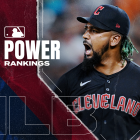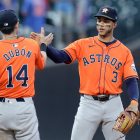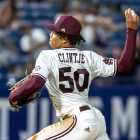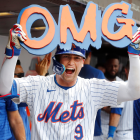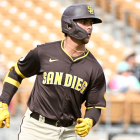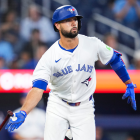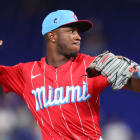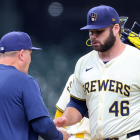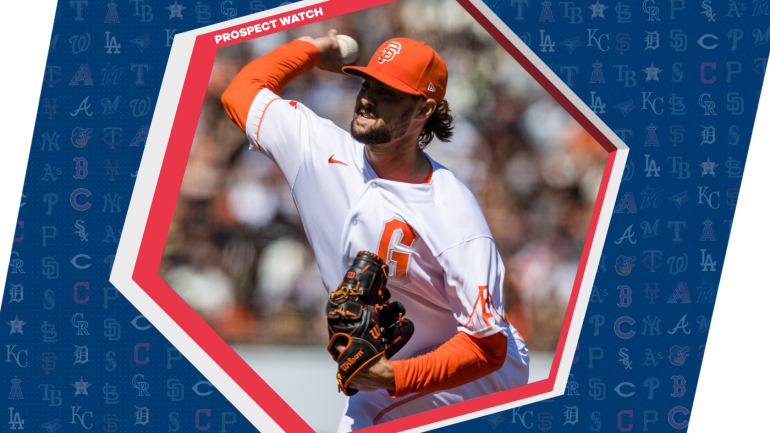
Major League Baseball's trade deadline comes earlier than normal this year. The league pushed up the deadline a day, from July 31 to July 30, to prevent it coinciding with scheduled day games -- that way teams don't have to concern themselves with playing short, or with risking potential injury. That makes this an opportune time to highlight which prospects could be moved between then and now.
Rather than highlight top prospects who seldom get moved, we're subverting the concept by emphasizing the players whose availability is dictated by logistics. As we explained last year, that means by and large focusing on 40-player rosters who have nearly exhausted their options, or looking for Rule 5-eligible youngsters who might not be able to crack the team's 40-player roster over the winter.
Below, you'll find 37 players from 14 probable buyers -- 13 obvious contenders and the Atlanta Braves, who have already made a couple of additions. Again, we're not declaring these players to be available based on inside information; just a hunch based on how teams operate.
The teams are presented in alphabetical order.
Atlanta Braves
We're starting with a pair of up-and-down arms who will be without options heading into next spring: lefty Sean Newcomb and righty Bryse Wilson.
Newcomb has enjoyed much big-league success to date, tallying 4.4 Wins Above Replacement from 2017-19 while splitting time between the rotation and the bullpen. The past season-plus hasn't been kind to him, however, as his tenuous feel for the strike zone has eroded, resulting in 25 walks in his last 35 innings. Newcomb has thrown harder this season than he did previously, and a new cutter has proven to be effective while supplanting his changeup and curveball as his top secondary offering. He's going to be non-tendered, in all likelihood, but an interested team could try to help him sort out his issues now, and could then keep him around if they like how he responds.
Wilson doesn't have Newcomb's stuff or track record, but he does have significantly better command and he isn't anywhere close to being eligible for arbitration. Wilson's biggest flaw is his arsenal depth. He commands his low-to-mid-90s fastballs well and his changeup is often above-average. His breaking stuff isn't as good, leaving him with a limited ceiling. Wilson will turn 24 in December, so it's easy to see a team giving him a chance to figure it out.
Outfielder Trey Harris is the second-best outfield prospect in the system with that surname. He doesn't have a standout tool and he's going to turn 26 before next spring, but there might be just enough there to profile as a bench bat. Right-hander Freddy Tarnok is a former third-round pick who has punched out more than 15 batters per nine innings in seven Double-A appearances. His inconsistency is understandable, given he's relatively new to pitching on a full-time basis, but it could cause the Braves to give up the ghost on his upside.
Boston Red Sox
Right-hander Frank German came over as part of Boston's agreement with the Yankees to absorb Adam Ottavino's contract. German has scuffled in his first taste of Double-A action, posting a 5.33 ERA and a 1.73 strikeout-to-walk ratio in 12 appearances (11 of them starts). A team convinced his fortunes will change for the better with a move to the bullpen could see him as desirable.
We'll note two other members of Boston's Double-A staff: Andrew Politi, a starter conversion project who has already outperformed expectations from his 15th-round selection spot; and Durbin Feltman, a pure reliever who hasn't moved as quickly as the Red Sox expected he would when they made him the 100th pick in the 2018 class. Both could debut within the next year.
Chicago White Sox
Many of the most interesting prospects in the White Sox system have graduated to the majors this season, including Andrew Vaughn, Nick Madrigal, and Michael Kopech. We'll mention two arms who might catch the eyes of other teams. Lefty Hunter Schryver could pitch in middle relief at some point this year. Meanwhile, righty Kade McClure may appeal to teams as a potential back-end starter or swingman.
Cincinnati Reds
TJ Friedl is a contact-driven speedster who could probably slot in as someone's fourth outfielder the day after the trade. Another outfielder, Allan Cerda, has good raw power but has struck out in nearly a third of his plate appearances in A-ball. It takes only one club who thinks they can fix his swing, we guess.
Houston Astros
Shawn Dubin hasn't pitched since May, but he's listed on the Sugar Land Skeeters' active roster now and his fastball-slider combination is good enough to envision him making his big-league debut before the end of the season. Austin Hansen is a three-pitch righty who could also make it to the Show this year -- provided, anyway, that he starts throwing more strikes, as he's issued a free pass per inning pitched in six appearances to date. Let's complete the Skeeter hat trick by highlighting Brett Conine. He's having the best statistical season of the three despite being command-and-changeup right-hander. Many of the Astros' better pitching prospects are injured, so it's conceivable that Houston would value the next wave more than they normally would.
Los Angeles Dodgers
Devin Mann's seeming outbreak in 2019 hasn't carried over to Double-A. He's still walking, but his .219 average and .135 ISO aren't going to cut it from an infielder whose defense is considered substandard. Outfielder James Outman runs well (he's stolen 21 bases in 63 games) and has above-average raw power. He's an attrition risk if his strikeout rate ticks up anymore as he climbs the ladder; that's not promising given his next stop is Double-A.
Milwaukee Brewers
The Brewers don't have a standout farm system, but they do have several players worth mentioning, albeit briefly, in this piece. An idealized version of catcher Payton Henry has him slugging enough to make up for his contact and defensive deficiencies; he's homered once in his first 44 games this season, suggesting it might be time to dream up a new ideal. Righty Victor Castaneda spent 2019 in the bullpen. He's moved back to the rotation this year, and he's had enough success at High-A to envision him remaining there for a little longer. Fellow right-hander Cam Robinson is a wild reliever without the stuff that makes one think he's going to be able to make it work in the majors.
New York Mets
The Mets don't have a deep system, so their options under our prerequisites are limited. Carlos Cortes is the ever-rare switch-thrower. He doesn't have a true defensive home, but he might just hit enough to be a reserve. Right-hander Jose Butto is a changeup artist who teams have passed over before in the Rule 5 draft.
New York Yankees
Right-hander Glenn Otto made just four starts at Rice, but the Yankees have used him almost exclusively as a starter. He didn't allow a run in three of his last four outings at Double-A before, just this past week, getting pushed to Triple-A. His fastball-curveball combination is quite good, and gives him a lofty relief ceiling if he can't cut it as a starter.
Switch-hitting Oswaldo Cabrera doesn't receive the press afforded to some of the other infielders in the system, like Oswald Peraza and Ezequiel Duran, but he's followed up a breakout 2019 by hitting .252/.300/.496 with 12 home runs in 58 games at Double-A. For reference, his previous career-high in home runs for a single season was eight. The Yankees have a number of other individuals who fit the billing, including outfielder outfielder Everson Pereira, who the team signed for $1.5 million in 2017.
Oakland Athletics
Right-hander Brady Feigl hasn't generated fewer than 50 percent grounders or issued more than 3.15 walks per nine in any of his professional seasons. He doesn't have big-time stuff, but his control and ability to coerce grounders could give him a future as a back-end starter or middle reliever. Speaking of middle relievers, Aiden McIntyre is a fastball-dependent right-hander who is experiencing life at the Double-A level for the first time.
San Diego Padres
Steven Wilson is a fastball-slider reliever who has taken well to Triple-A and who should be in consideration for a big-league promotion sometime during the second half. Eguy Rosario was not drafted in last winter's Rule 5, but he's having a good run at Double-A and it's at least possible someone sees him as a bat-first bench type. Brandon Valenzuela is a promising defensive catcher with enough stick to envision him holding down at least a backup job someday.
San Francisco Giants
We'll start with a pair of 40-player pitchers, in Tyler Beede and Conner Menez.
Beede recently made his first big-league appearance since September 2019, an absence owed to -- what else? -- Tommy John surgery. Beede has always had trouble putting everything together, and it doesn't help his marketability that he's walked 32 batters in 35 2/3 minor-league innings this season. Perhaps some team sees him as an interesting flier type, but that's about as far as you can go.
Menez has changed his approach at the big-league level, moving from a fastball-dominant pitcher to one who leans on his slider as his primary offering. Unfortunately he, like Beede, has struggled to throw strikes in Triple-A.
How about two prospects with similar control issues this season? Lefty Seth Corry punched out 172 batters in 122 innings in 2019. He's still sporting an impressive K rate (14 per nine), but he's issuing far too many free passes (roughly one per inning) to be effective. (His stuff isn't as good as those strikeouts suggest, either.) Righty Prelander Berroa is on the smaller side and has issued more than a walk every other inning for his career. His stuff is quality, though, and he should have a future in a relief role.
Tampa Bay Rays
Right-hander Joe Ryan, a member of Team USA's Olympic roster, is one of the hardest pitching prospects to pin down. In 53 innings at Triple-A this season, he posted a 3.57 ERA and a 7.00 strikeout-to-walk ratio. He's not a bigger deal nationally because even analysts with other teams don't understand how he's been able to succeed so much with a fastball-first approach given that his heater doesn't have outstanding metrics.
The Rays have continued to experiment with Ford Proctor, having him split the season between catcher and shortstop at Double-A. His best offensive skill at this point is drawing walks. Outfielder Cal Stevenson has already been traded twice and profiles as a reserve. Righty Michael Mercado has a chance to become a big-league starter, but he might get lost in the shuffle in Tampa Bay. (To state the obvious: these aren't the prospects you're chomping at the bit to acquire if you're dealing with the Rays.)
Toronto Blue Jays
Reliever Patrick Murphy has made 10 big-league appearances over the past two seasons. He has a hard mid-to-upper-90s sinker and a top-down curveball to keep batters honest. He also has an extensive injury history, including both Tommy John surgery and an operation to correct his thoracic outlet syndrome. Murphy could appeal to teams as a readymade bullpen piece.
Middle infielder Leo Jimenez is bereft of in-game power (he's yet to homer in nearly 600 professional regular-season plate appearances), but he's skilled at putting the ball in play and he's a quality defender. A team might glance at his birthdate (he won't turn 21 until next May) and convince themselves there's more than a utility ceiling here.










